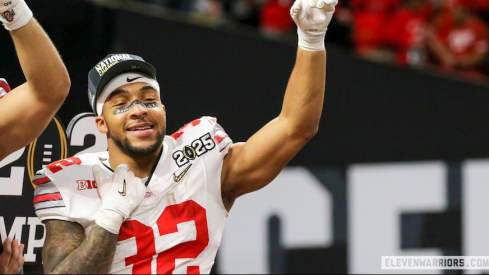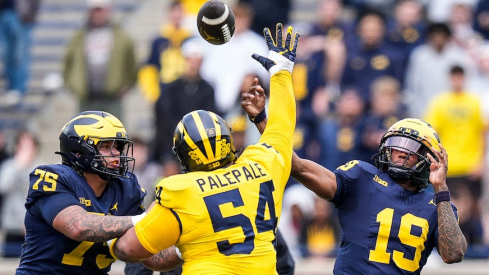With the Ohio State infomercial that was the NFL Draft having come and gone, the reality that Urban Meyer and company return just three starters on each side of the football must be faced.
Yes, the current roster is loaded with bluechip talent complemented by some quality – if not quantity – returnees highlighted by quarterback J.T. Barrett but a lack of proven commodities is cause for concern.
It might not be science but I think it's a fair assumption to believe losing up to 15 NFL-caliber players likely decreases Ohio State's margin for error heading into the upcoming season. As such, reducing potential negative impact in key stats such as turnover margin could be crucial in validating the phrase "we don't rebuild, we reload".
Of course, like any statistic, turnover margin can't be evaluated in a vacuum but knowing how turnovers can change the momentum of a game and therefore influence the overall success of a season, I looked back at each year since Meyer's arrival in Columbus to see how the Buckeyes stacked up nationally.
| YEAR | FUM LOST | INT | TOTAL TO | TAKEAWAYS | TO MARGIN | NATL RANK |
|---|---|---|---|---|---|---|
| 2012 | 11 | 7 | 18 | 21 | +3 | 48 |
| 2013 | 10 | 9 | 19 | 24 | +5 | 37 |
| 2014 | 14 | 12 | 26 | 33 | +7 | 33 |
| 2015 | 9 | 9 | 18 | 21 | +3 | 48 |
| TOTAL | 44 | 37 | 81 | 99 | +18 | 41 (AVG) |
Not surprisingly, the Buckeyes landed on the right side of the plus/minus ledger each year. During the perfect 2012 season that relied on some level of smoke and mirrors in winning six games by seven points or less, Ohio State ranked just 48th nationally in turnover margin at +3.
A year later, the squad improved to +5, good for 37th nationally, on the strength of the defense adding three more turnovers to the resume. Winners of their first 12 games, Ohio State dropped the last two; against Michigan State in the B1G title game and Clemson in the Orange Bowl.
The Buckeyes were actually +1 in turnover margin in the 34-24 loss to Sparty proving the statistic isn't always a factor but in the 40-35 loss to the Tigers, they turned it over four times with three in particular showcasing how fatal such miscues can be against good teams.
Leading 29-20 late in the 3rd quarter, Philly Brown muffed a punt and the Tigers jumped on it at the OSU 33 yard line. Three plays later Tahj Boyd hit Sammy Watkins for a 30-yard touchdown trimming the lead to 29-27.
On the ensuing possession, Braxton Miller threw a pick giving Clemson possession at the OSU 38. Four plays later Boyd tossed another touchdown and Ohio State trailed 34-29 with under a minute left in the 3rd quarter.

Finally, trailing 40-35 with just over a minute left and possession at the Clemson 48 yard line Miller was intercepted on a 2nd and 10 play ending any chance at victory. The four total miscues despite the defense forcing two Boyd interceptions were simply too much to overcome ending the season on a sour note.
A year later the 2014 squad would go on the capture the national championship and perhaps not coincidentally, they posted the best turnover margin of the Meyer era in Columbus at +7 thanks largely to an opportunistic defense (33 forced TO), good for 33rd nationally.
During the lone blemish on an otherwise perfect season, Ohio State turned it over three times – all interceptions thrown by Barrett – including a pick-six with less than a minute to play putting the last nail in the coffin of a 35-21 loss in the Shoe.
While turnovers loomed large in the loss to the Hokies, wins over Alabama and Oregon in the college football playoff showed how miscues can be overcome with elite talent as the Buckeye offense turned it over six times while the defense created four. Despite the -2 turnover margin over the two games Ohio State's loaded roster outscored its opponents by 29 points.
Last season Meyer's troops gave it away at a better clip with 18 turnovers but the defense wasn't as adept at creating them, posting 21, giving the team a +3 turnover margin which finished at a pedestrian 48th nationally. In their lone loss of the season however, the Buckeyes didn't turn it over while the defense yielded an interception during the season-crushing 17-14 loss.
| SPAN | OFF TO | DEF TO | TO MARGIN |
|---|---|---|---|
| ALL 54 GAMES | 81 | 99 | +18 |
| 50 WINS | 74 | 91 | +17 |
| 4 LOSSES | 7 | 8 | +1 |
Roll those four seasons together and Ohio State has a +18 turnover margin over all 54 games. In the 50 wins, the turnover margin stays healthy at +17 with 74 miscues offset by 91 turnovers created by the defense. In the four losses however, the offense coughed it up seven times while the defense produced eight, giving the Buckeyes just a +1 margin.
Those collective numbers highlight the benefits of winning the turnover battle and how losing it can be an equalizer.
Considering the noted chore to fill positional holes vacated by NFL-level talent with largely unproven talent, playing disciplined football will be job one for the 2016 squad especially as it finds its footing amid a schedule that takes it to Oklahoma in week three and to hostile environments at Wisconsin and Penn State during back-to-back weeks midway through the season.
The good news amid all the roster turnover is Barrett returns at quarterback giving the offense a steadying influence. Even with Barrett running the show, the offense will still rely heavily on guys like Mike Weber and Noah Brown who didn't even play a snap a season ago along with guys like Curtis Samuel and Dontre Wilson who will see expanded roles to take care of the football.
If the offense can keep the turnovers at no greater than the mid-to-high teens, then history says losses could be at a minimum but if those numbers creep over 20, it will take a determined effort by a green defense to create a positive turnover margin that could be crucial to determining whether or not the 2016 season is successful one.


